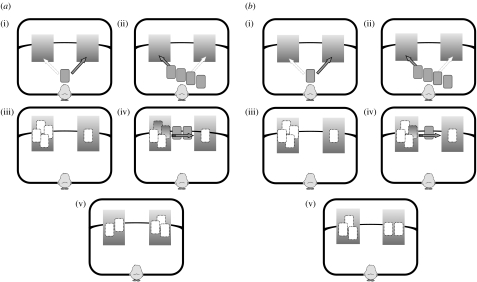Figure 3.
Schematic representing, from the perspective of the confined chick, the events occurring in experiment 3 within: (a) one possible trial of the FEC test (in the ‘(4−2) versus (1+2)’ condition, see text); (b) one possible trial of the last event controlled test (in the ‘(4−1) versus (1+1)’ condition, see text). (a(i)) FE: one ball is hidden behind one screen. (ii) Four balls are hidden—one by one—behind the other screen. The sequence of events and the directions were randomized between trials. (iii) At the end of the first displacement either four or one ball(s) are hidden behind each screen. (iv) SE: two balls move—one by one—from the screen hiding four to the one hiding a single ball. (v) Test: the chick is released in the arena and should rejoin the larger number of imprinting balls, which is NOT behind the screen where the larger number of balls had initially disappeared. (b(i)) FE: one ball is hidden behind one screen. (ii) Four balls are hidden—one by one—behind the other screen. The sequence of events and the directions were randomized between trials. (iii) At the end of the first displacement either four or one ball(s) are hidden behind each screen. (iv) SE: one ball moves from the screen hiding four to the one hiding a single ball. (v) Test: the chick is released in the arena and should rejoin the larger number of imprinting balls, which is NOT behind the screen where the final hiding of balls has been observed.

